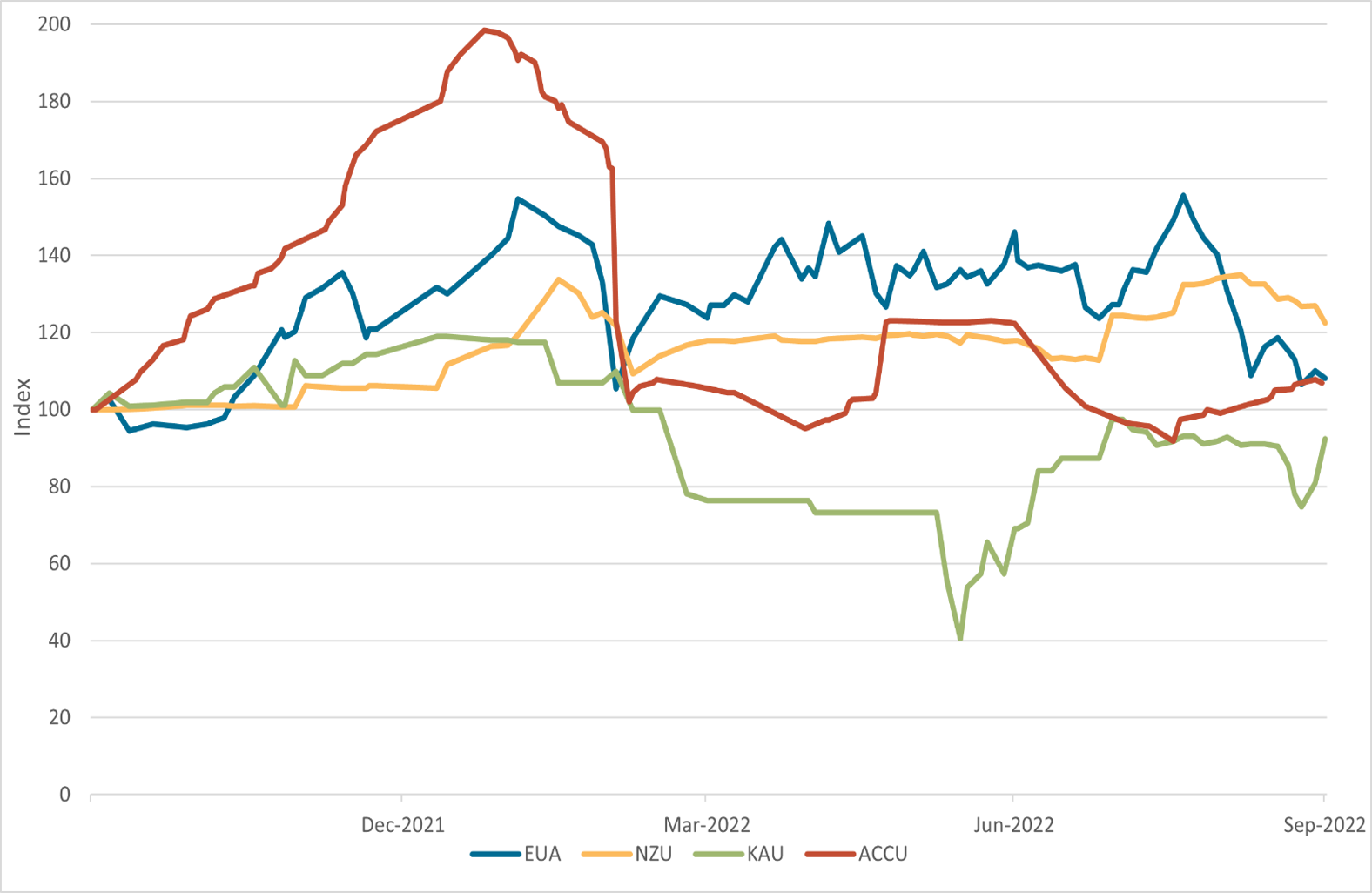International carbon markets continue to be volatile, affected by changing policy, market uncertainty and global macro-economic conditions.
Q3 2022 saw the European Union Allowance (EUA) spot price climb to an all-time high of €99.22 in August before tumbling to a six-month low, ending the quarter at €66.73. This was a 26% decrease from Q2 2022, but 8% higher than Q3 2021 (see Figure 4.1). The initial uptick of the EUA spot price follows an annual trend, as there is a 50% reduction in auction volumes of new contracts made available for the month of August. Reduced supply available to the market combined with the energy crisis and policy uncertainty has contributed to volatility in the EUA market in this quarter.
In July, the European commission proposed to cut gas usage by 15% over 8 months from August 2022 to reduce reliance on Russian gas and build up stores for winter. This had the potential to reduce industrial emissions and associated future demand for EUAs, which saw a short-lived dip in the EUA spot price. The EUA market bounced back in August driven by low auction volumes available, high-energy prices and sustained buying. However, as energy prices remained turbulent and full auction volumes returned in September, the EUA market declined. The EUA market is still awaiting outcomes of the Fit for 55 trilogue negotiations and the funding decisions for the REPowerEU plan, both of which are likely to have major impacts on the EU Emissions Trading Scheme (ETS).
The New Zealand Unit (NZU) spot price reached a record high of NZ$88.50 in Q3 2022 before softening to end the quarter at NZ$79.00 (see Table 4.1). The release of the New Zealand Climate Change Commission’s NZ ETS reform advice, including the recommendations for a large increase in the Cost Containment Reserve price and a reduction in the number of allowances available at auction, created uncertainty in the NZU market over the quarter.1
Potential tightening of future supply and a bullish sentiment for the September auction drove the NZU spot price to rise rapidly. However, the spot price fell following a lower than expected clearing price and bidding, as well as continued uncertainty around ETS reforms.
The Korean Allowance Unit (KAU) bounced back this quarter, increasing 34% to ₩27,500. This increase can be attributed to three successful auctions over the quarter, an expected shortage of KAU supply in 2022 and the resulting thin liquidity in the market. The South Korean government is set to strengthen their ETS and has begun negotiations with several countries under Article 6.2, aiming to cut emissions by 40% below 2018 levels by 2030.
EUA, NZU, KAU, and generic ACCU spot prices
30 September 2021 to 30 September 2022, indexed to 30 September 2021 Note: This figure is not interactive.
Description
This graph shows indexed spot prices for EUA, NZU, KAU, and generic ACCUs over time.
Small print
Sourced from TFS Green, Jarden, Ember, Carbon News, KRX.
| Product | Spot price (30 Jun 2022) | Spot price (30 Sep 2022) | Quarterly change | Spot price (30 Sep 2022) Australian dollar terms* |
|---|---|---|---|---|
| European Union Allowances (EUA) | €90.16 | €66.73 | -€23.43 (-26.0%) | $100.60 |
| New Zealand Units (NZU) | NZ$76.00 | NZ$79.00 | NZ$3 (3.9%) | $69.34 |
| Korean Allowance Units (KAU) | ₩20,550 | ₩27,500 | ₩6,950 (33.8%) | $29.59 |
*Exchange rate as at 30 September 2022
Footnotes
1 The Cost Containment Reserve is an instrument designed to ease demand pressure and act as a price ceiling in the New Zealand Emissions Trading System.